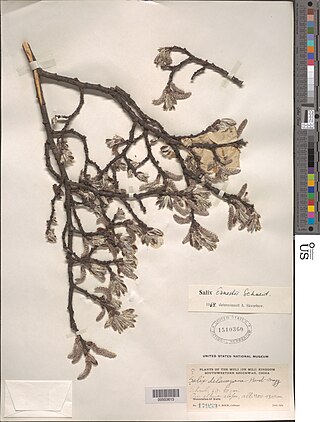
Salix argyracea is a large shrub from the genus of willow (Salix) with up to 10 centimeters long leaf blades with a felty hairy and shiny underside. The natural range of the species is in Kazakhstan, Kyrgyzstan, and China.
Salix cathayana is a strongly branched shrub from the genus of the willow (Salix) with brown or gray-brown, young tomentose hairy branches. The leaf blades have lengths of 1.5 to 5.2 centimeters. The natural range of the species is in the north of China.
Salix balfouriana is a shrub or small tree from the genus of willow (Salix) with reddish black and tomentose hairy young twigs and up to 8 leaf blades, rarely 18 centimeters long. The natural range of the species is in China.
Salix annulifera is a small shrub from the genus of the willow (Salix) with up to 8 centimeter long leaf blades. The natural range of the species is in China.
Salix atopantha is a small shrub from the genus of the willow (Salix) with up to 4 centimeters long, dull brown leaf blades on top. The natural range of the species is in China.
Salix chikungensis is a shrub in the willow genus Salix with tomentose hairy and later balding branches. The leaf blades have lengths of 6 to 8.5 centimeters. The natural range of the species is in China.
Salix chingiana is a small tree in the willow genus Salix with dull purple-colored, bare branches. The stipules are permanent, the leaf blades are 7 to 10 centimeters long. The natural range of the species is in China.

Salix clathrata is a prostrate shrub in the willow genus Salix with spread, heavily branched branches. The leaf blades have lengths of 1.5 to rarely 3 centimeters. The natural range of the species is in China.

Salix cheilophila is a shrub or small tree from the genus of willow (Salix) with initially tomentose hairy and later balding branches. The leaf blades have lengths of 2.5 to sometimes 6 centimeters. The natural range of the species is in China.
Salix cupularis is a small shrub from the genus of the willow (Salix) with 1.5 to 2.7 centimeters long leaf blades. The natural range of the species is in China.
Salix daliensis is a shrub from the genus of willows (Salix) with mostly 5 to 6 centimeters long leaf blades. The natural range of the species is in China.
Salix daltoniana is a shrub or small tree from the genus of the willow with mostly 4.5 to 9 centimeters long leaf blades. The natural range of the species is in India, Nepal, Bhutan, and in Tibet.
Salix dalungensis is a small tree from the genus of willow (Salix) with mostly 4 to 5 centimeters long leaf blades. The natural range of the species is in Tibet.
Salix delavayana is a shrub or small tree from the genus willow (Salix) with mostly 3 to 8 centimeters long leaf blades. The natural range of the species is in the south of China and in Tibet.
Salix dibapha is a shrub from the genus of willow (Salix) with mostly 4 to 6 centimeters long leaf blades. The natural range of the species is in China.
Salix dissa is a low shrub from the genus willow (Salix) with usually 1 to 3 centimeters long leaf blades. The natural range of the species is in China.
Salix divergentistyla is a shrub or tree from the genus of willow (Salix) with mostly 3 to 4.5 centimeters long leaf blades. The natural range of the species is in Tibet.

Salix driophila is a shrub from the genus of willow (Salix). The natural range of the species is in China.

Salix erioclada is a species from the genus of willows (Salix) and grows as a shrub or small tree. The leaf blades have a length of about 5 centimeters. The natural range of the species is in China.

Salix ernestii is a species in the genus of willow (Salix) and grows as a shrub. The leaf blades are about 11 centimeters long. The natural range of the species is in China.






